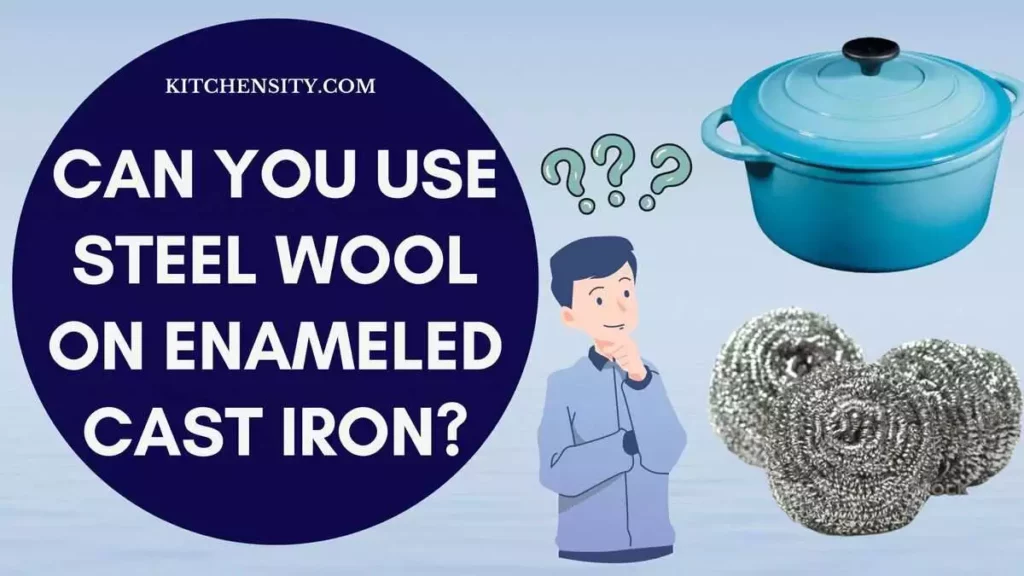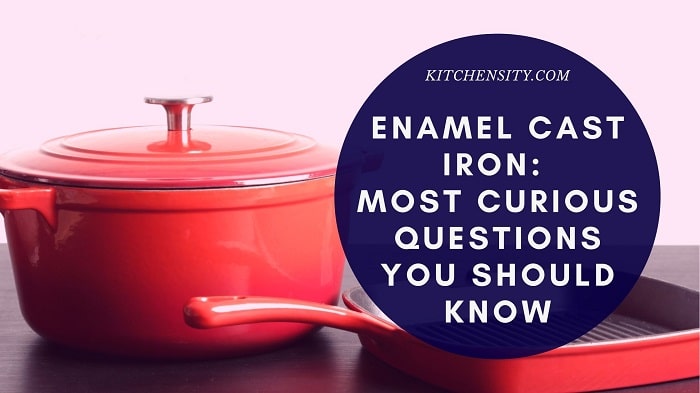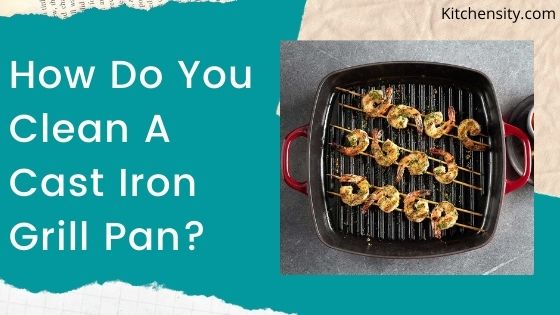Are you a proud owner of enameled cast iron cookware and wondering about the best way to keep it clean and well-maintained?
One common question that arises is whether it is safe to use steel wool on enameled cast iron.
Steel wool, known for its abrasive properties, can be a powerful cleaning tool, but is it suitable for your precious enameled cast iron pots and pans?
In this article, we will delve into the topic and explore the factors, risks, and alternatives to using steel wool on enameled cast iron.
By the end, you’ll have a clear understanding of how to keep your cookware in top-notch condition without risking any damage.
So, let’s dive in and uncover the secrets of cleaning and maintaining your beloved enameled cast iron cookware!

Table of Contents
- 1 Can You Use Steel Wool On Enameled Cast Iron?
- 2 Factors To Consider Before Using Steel Wool On Enameled Cast Iron
- 3 Risks Of Using Steel Wool On Enameled Cast Iron
- 4 Alternatives To Steel Wool For Cleaning Enameled Cast Iron
- 5 Cleaning And Maintaining Enameled Cast Iron
- 6 Final Verdict
- 7 YOU MAY ALSO LIKE
- 8 FAQs
- 8.1 Can You Use Steel Wool On Le Creuset?
- 8.2 Is It Ok To Use Steel Wool On Cast Iron?
- 8.3 Can You Use Steel Wool On A Dutch Oven?
- 8.4 Can Steel Wool Scratch The Enamel Surface?
- 8.5 Will Steel Wool Damage The Non-Stick Properties Of The Enamel?
- 8.6 Are There Specific Types Of Steel Wool Suitable For Enameled Cast Iron?
- 8.7 What Are The Alternative Cleaning Methods For Tough Stains On Enameled Cast Iron?
Can You Use Steel Wool On Enameled Cast Iron?
Using steel wool on enameled cast iron is generally not recommended. Steel wool is abrasive and can potentially scratch or damage the enamel surface, compromising its appearance and functionality. It is advisable to use alternative cleaning methods and tools specifically designed for enameled surfaces to ensure proper care and maintenance of enameled cast iron cookware.
Also Read – Can You Use Vinegar On Enameled Cast Iron?
Factors To Consider Before Using Steel Wool On Enameled Cast Iron
Before deciding to use steel wool on enameled cast iron cookware, there are several factors to consider:
- Enamel Condition: Assess the condition of the enamel coating on the cast iron. If the enamel is already chipped, cracked, or worn down in certain areas, using steel wool may further damage the surface and expose the underlying cast iron, which can be prone to rusting.
- The Severity Of Stains Or Build-Up: Determine the severity of the stains or build-up on the enameled cast iron. In most cases, mild stains and residues can be easily removed with gentler cleaning methods, making the use of steel wool unnecessary.
- Age Of The Cookware: Older enameled cast iron cookware may be more susceptible to damage from abrasive materials like steel wool. If your cookware is decades old, it’s best to exercise caution and avoid using steel wool.
- Thickness Of The Enamel Coating: Thicker enamel coatings tend to be more durable and resistant to scratching. If your enameled cast iron has a thin enamel layer, using steel wool may pose a higher risk of damaging the surface.
- Frequency Of Use: If you frequently use your enameled cast iron cookware, it’s essential to consider the long-term effects of using steel wool. Over time, repeated use of steel wool may wear down the enamel and affect the appearance and functionality of the cookware.
- Personal Preference: Some individuals have a higher tolerance for minor scratches or imperfections on their enameled cast iron. If you are less concerned about preserving the pristine appearance of your cookware, using steel wool sparingly and with caution may be an option.
- Manufacturer’s Recommendations: Refer to the manufacturer’s instructions or guidelines for the specific enameled cast iron cookware you have. Some manufacturers may explicitly advise against using steel wool, while others may provide specific recommendations for cleaning and maintenance.
Also Read – Can You Put Enamel Cast Iron In The Dishwasher?
Risks Of Using Steel Wool On Enameled Cast Iron
While steel wool can be effective in removing stubborn stains or residue from various surfaces, there are potential risks associated with using it on enameled cast iron:
- Scratching The Enamel: Steel wool is abrasive and can potentially scratch or dull the enamel coating on the cast iron. These scratches not only compromise the appearance of the cookware but can also create rough surfaces that may be more difficult to clean in the future.
- Exposing Cast Iron: If the enamel coating is already damaged or worn down in certain areas, using steel wool can further chip or remove the remaining enamel, exposing the cast iron beneath. This can lead to rusting and compromise the non-reactive properties of the cookware.
- Damaging The Non-Stick Properties: Enameled cast iron often has a naturally non-stick surface due to the smooth enamel coating. Using steel wool can roughen the surface and potentially diminish its non-stick properties, making food more likely to stick during cooking.
- Releasing Metal Particles: Steel wool can leave behind small metal particles or fragments on the enamel surface. These particles can be difficult to remove and may cause issues if ingested accidentally.
Also Read – How To Clean A Cast Iron Grill Pan?
Alternatives To Steel Wool For Cleaning Enameled Cast Iron
These are some alternate methods to clean your enamel cast iron cookware:
- Gentle Scrubbing: For mild stains or residue, opt for a soft sponge or cloth with mild dish soap and warm water. This method allows you to gently scrub the surface without the risk of scratching the enamel. Remember to avoid using abrasive scrubbers or brushes.
- Baking Soda Paste:
- Create a paste using baking soda and water.
- Apply the paste to the stained areas of the enameled cast iron and let it sit for a while, allowing the baking soda to work its magic.
- Afterward, gently scrub the surface with a non-abrasive sponge or cloth.
- Baking soda is a natural abrasive that can help remove stubborn stains without causing damage to the enamel.
- White Vinegar Solution:
- Mix equal parts of white vinegar and water in a bowl or basin.
- Submerge the stained area of the enameled cast iron in the solution and let it soak for some time, typically 20-30 minutes.
- The acidic properties of white vinegar can help break down stains or build up.
- After soaking, use a non-abrasive sponge or cloth to gently scrub the surface.
- Enamel-Safe Cleaners: Look for cleaners specifically designed for cleaning enameled surfaces. These cleaners are formulated to be non-abrasive and safe for use on enameled cast iron cookware. Follow the instructions provided by the manufacturer to effectively clean your enameled cast iron without causing any damage.
- Lemon And Salt Mixture: Cut a lemon in half and sprinkle some salt on the cut side. Use the lemon as a scrubber and gently rub it on the stained areas of the enameled cast iron. The natural acidity of the lemon combined with the abrasiveness of the salt can help remove stains. Rinse the cookware thoroughly after scrubbing.
- Cream Of Tartar Paste: Mix cream of tartar with a small amount of water to create a paste. Apply the paste to the stained areas and let it sit for a while. Then, gently scrub with a non-abrasive sponge or cloth. Cream of tartar is a mild abrasive that can help lift stains without damaging the enamel.
Remember, when using any of these alternatives, it’s important to be gentle and avoid excessive scrubbing or using abrasive tools.
By choosing these gentler methods, you can effectively clean your enameled cast iron cookware while preserving its enamel coating and extending its lifespan.
Also Read – Why Does Food Stick To My Enamel Cast Iron?
Cleaning And Maintaining Enameled Cast Iron
Cleaning and maintaining enameled cast iron cookware is essential to keep it in optimal condition for years of reliable use.
By following proper cleaning techniques and implementing regular maintenance practices, you can ensure that your enameled cast iron retains its beauty and functionality.
Proper Cleaning Techniques For Enameled Cast Iron
- Hand-Washing: Enameled cast iron should be hand-washed to avoid potential damage from harsh dishwasher detergents or high heat.
- Cool-Down Period: Allow the enameled cast iron to cool down before cleaning to avoid the thermal shock that could damage the enamel.
- Gentle Scrubbing: Use a soft sponge or cloth to gently scrub the surface of the cookware. Avoid abrasive scrubbers or brushes that can scratch the enamel.
- Mild Dish Soap: Use a bar of mild dish soap and warm water to clean the cookware. Avoid using harsh or abrasive cleaners that can damage the enamel.
- Soaking For Tough Stains: For stubborn stains, soak the enameled cast iron in warm water with a few drops of mild dish soap. This can help loosen the stains and make them easier to remove.
- Avoid Soaking For Extended Periods: While soaking can be helpful, avoid leaving enameled cast iron submerged in water for an extended period as it can lead to moisture-related issues.
Also Read – Does Enamel Cast Iron Chip?
Recommended Cleaning Tools For Enameled Cast Iron
- Soft Sponge Or Cloth: Use a soft sponge or cloth to gently scrub the surface of the enameled cast iron. Avoid using abrasive scrubbers or brushes that can scratch the enamel.
- Non-Abrasive Scrubbing Pad: If needed, use a non-abrasive scrubbing pad specifically designed for non-stick surfaces. Ensure it is gentle and safe for use on enameled cast iron.
- Nylon Or Silicone Utensils: When cleaning, use nylon or silicone utensils to avoid scratching the enamel coating. These materials are softer and less likely to cause damage.
Tips For Maintaining The Enamel Coating
- Avoid Extreme Temperature Changes: Rapid temperature changes can cause thermal shock and potentially damage the enamel. Gradual temperature changes are recommended.
- Use Proper Cooking Utensils: When cooking with enameled cast iron, use wooden, silicone, or nylon utensils instead of metal ones. Metal utensils can scratch the enamel.
- Proper Storage: Ensure the enameled cast iron is completely dry before storing it to prevent moisture-related issues. Place a towel or a paper towel between stacked pieces to prevent chipping or scratching.
- Avoid Abrasive Cleaners Or Scouring Pads: Harsh cleaners and abrasive scouring pads can damage the enamel. Stick to mild dish soap and non-abrasive cleaning tools.
- Address Chips Or Cracks Promptly: If you notice any chips or cracks in the enamel coating, avoid using the cookware until it is repaired. Small chips can be addressed with enamel repair kits available in the market.
By following proper cleaning techniques and maintaining the enamel coating, you can prolong the lifespan and appearance of your enameled cast iron cookware.
Regular care and maintenance will ensure it continues to perform well and retain its aesthetic appeal.
Also Read: How To Season And Clean Cast Iron Cookware?
Final Verdict
In conclusion, using steel wool on enameled cast iron cookware is generally not recommended. The abrasive nature of steel wool can potentially scratch or damage the delicate enamel surface, compromising the appearance and functionality of the cookware.
Instead, opt for alternative cleaning methods such as gentle scrubbing with mild dish soap, using baking soda paste, or employing enamel-safe cleaners.
By choosing these alternatives, you can effectively clean and maintain your enameled cast iron cookware while preserving its integrity and ensuring its longevity.
Remember, proper care and maintenance are key to keeping your enameled cast iron in pristine condition for many enjoyable cooking experiences ahead.
YOU MAY ALSO LIKE
- Is Enameled Cast Iron Cookware Safe?
- Cast Iron Skillet Gift Basket Ideas
- Do You Need To Season Enameled Cast Iron?
- Best Enameled Cast Iron Cookware Sets
- Best Cast Iron Pots And Pans Set
- How To Season And Clean Cast Iron Cookware?
- How Many Quarts In An 8×8 Pan?
- How Many Quarts Are In A 9×9 Pan?
- How Many Quarts In A 9×13 Pan?
- Skillet Vs Frying Pan Vs Sauté Pan
FAQs
-
Can You Use Steel Wool On Le Creuset?
No, it is not recommended to use steel wool on Le Creuset or any other enameled cookware as it can potentially scratch or damage the enamel surface.
-
Is It Ok To Use Steel Wool On Cast Iron?
Using steel wool on bare cast iron is generally acceptable for removing tough stains or rust, but caution must be exercised to avoid removing the seasoning layer. However, it is not recommended for enameled cast iron.
-
Can You Use Steel Wool On A Dutch Oven?
It is not advisable to use steel wool on a Dutch oven, especially if it is made of enameled cast iron. Steel wool can scratch or damage the enamel coating, compromising the appearance and performance of the Dutch oven.
-
Can Steel Wool Scratch The Enamel Surface?
Yes, steel wool is abrasive and has the potential to scratch the enamel surface of enameled cast iron. It is important to use caution when using steel wool on enameled cast iron to avoid damaging the enamel coating.
-
Will Steel Wool Damage The Non-Stick Properties Of The Enamel?
Yes, using steel wool on enameled cast iron can roughen the surface and potentially diminish its non-stick properties. The abrasiveness of steel wool can create rough areas that may cause food to stick during cooking. It is advisable to avoid using steel wool on enameled cast iron to maintain its non-stick properties.
-
Are There Specific Types Of Steel Wool Suitable For Enameled Cast Iron?
While there are different grades of steel wool available, there are no specific types that are considered suitable for enameled cast iron. Steel wool is generally not recommended for use on enameled cast iron due to its potential to scratch or damage the enamel surface.
-
What Are The Alternative Cleaning Methods For Tough Stains On Enameled Cast Iron?
There are several alternative cleaning methods for tough stains on enameled cast iron that do not involve using steel wool.
These include creating a paste with baking soda and water, soaking the cookware in warm water with mild dish soap, using a non-abrasive scrubbing pad designed for non-stick surfaces, and trying a white vinegar and water solution.
These methods provide effective stain removal while protecting the enamel coating.
Katrina Smith is a seasoned expert with over 25 years of experience in all things related to cooking and the kitchen. As an avid cook and kitchen enthusiast, she is passionate about sharing her knowledge and expertise on cookware, kitchen appliances, kitchen tips, and kitchen staples.
Through her articles and reviews, Katrina aims to inspire and help others improve their cooking skills, experiment with different ingredients, and invest in quality cookware and appliances.

![How To Season And Clean Cast Iron Cookware? [4 Effective Ways] 3 How To Season And Clean Cast Iron Cookware](https://www.kitchensity.com/wp-content/uploads/2020/06/How-To-Season-And-Clean-Cast-Iron-Cookware.jpg)




